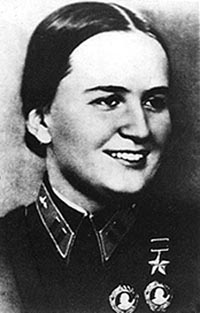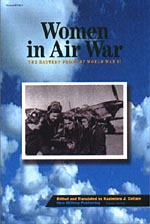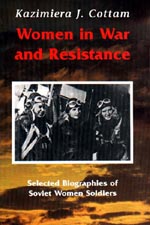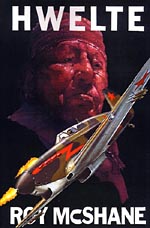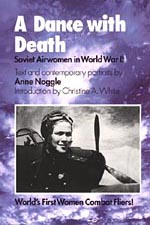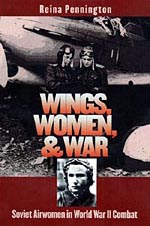
Marina Raskova and the Soviet Women Pilots of World War II
On June 22, 1941, Hitler's Wehrmacht invaded the Soviet Union, and Operation Barbarossa was under way. By November, the German army was just 19 miles from Moscow. Leningrad was under siege, three million Russians had been taken prisoner, a large part of the Red Army was wiped out and the air force was grounded. The situation looked hopeless. In the summer of 1941, Marina Raskova, a record-breaking aviatrix, organized the 588th night bomber squadron - composed entirely of women, from the mechanics to the navigators, pilot and officers.
One June 8, 1942, three planes took off on the first mission. The target: the headquarters of a German division. The raid was successful, but one aircraft was lost. The 588th fought non-stop for months, flying 15 to 18 missions a night. "It was a miracle we didn't lose more aircraft", recalls Nadia Popova. "Our planes were the slowest in the air force. They often came back riddled with bullets, but they kept flying." On August 2, 1942, her plane crashed in the Caucasus. She and her navigator were found alive a few days later. The winter of 1942 was brutal, with the temperature plummeting to -54o F during the battle of Stalingrad. Parts of the aircraft were so cold that they ripped the skin off of anyone who touched them. By January 1943, the women of the 588th were worn out. Sleepless nights, constant stress, the loss of friends and sexual harassment from male colleagues took their toll. Women in the 588th flew up to 500 night raids!
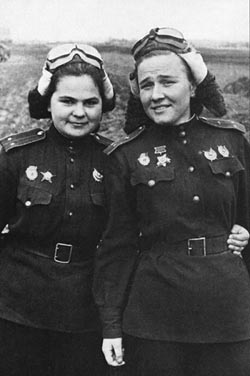 Katya Ryabova and Nadya Popova In a single night they made 18 bombing sorties into enemy territory Moolman, Valerie, Women Aloft, Time Life, 1981 download 500pixel image
From the battle of Stalingrad to the fall of Berlin, the regiment made 24,000 combat flights and dropped 23,000 tons of bombs. It was awarded the Soviet Union's highest collective military honor. Years after the war, Nadia Popova said, "At night sometimes, I look up into the dark sky, close my eyes and picture myself as a girl at the controls of my bomber and I think, 'Nadia, how on earth did you do it?"
Marina Raskova The Women's Air Service Pilots (WASP's) had key figures in their organization and implementation--Jacqueline Cochran and Nancy Love. For the Soviet women pilots, it was Marina Raskova. In 1938 Raskova and two other Soviet women had set a world record for a non-stop direct flight by women when they flew a Soviet-built, twin-engine aircraft named Rodina (homeland) 6,000 kilometers across the expanse of the Soviet Union from Moscow to Komsomolsk-on-Amur in the Far East. With the aircraft icing up over the Siberian wilderness, the women tossed everything movable out of the aircraft to try and gain altitude. Finally, Raskova, who had been the navigator, decided she would have to go as well. She marked the aircraft's compass heading on a map and bailed out into the darkness. The two remaining pilots eventually landed safely at their destination, and a hunter rescued Raskova. The three "Winged Sisters" returned triumphantly to Moscow. On June 22, 1941--a date that lives in infamy for the Russian people--the German blitzkrieg came to Mother Russia in the form of Operation Barbarossa. The Soviets planned three women air regiments, each with three squadrons of 10 aircraft. The mechanics, armament fitters, and other personnel would also be women. Each regiment would then have approximately 400 women. Thousands of applications were received and narrowed down to 2,000 to be interviewed. In 1942 the Soviet Union formed three regiments of women combat pilots who flew night combat missions and were so successful and deadly the Germans feared them, calling them Nachthexen--night witches. ...more
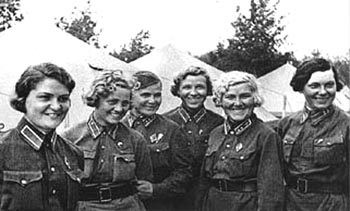
Pilots from the Russian 586th Women's Fighter Regiment
Marina Raskova and Soviet Female Pilots At the age of 19, Marina Raskova joined the Zhukovski's Aviation Academy. In 1934 Raskova graduated as the first woman in the USSR to officialy pass the aviation navigator exam, and during the next year she received her pilot's licence. On 28 October 1937 Raskova and Valentina Grizodubova, while flying an AIR-12, took the female world record in a long distance non-stop flight of 1,445 km. In 1938 she took part in two record flights: on 2 July with Polina Osipienko and W. Lomako, in a MP-1 flying boat, over a distance of 2,241 km, and on 24-25 September with V. Grizodubova and P. Osipienko, in an ANT-37, for a non-stop flight over a distance of 5,908 km. After a string of these record 'missions', Capt. Marina Raskova, at this time a 25 year old woman, was awarded the Gold Star of a Soviet Hero.
Marina Raskova A famous Soviet navigator who set many records during the 1930s. She and two others were the first women to be awarded the Hero of the Soviet Union medal in 1938 when they completed a dangerous Moscow to Komsomolsk-on-Amur (in the Russian Far East) flight in the 2-engined plane "Rodina", that broke the international women's distance record. Her influence and the military need for more human resources made it possible for her to be able to persuade Stalin to allow her to organize three regiments of women flyers. Already a folk heroine, and a Major in the Soviet Air Force by 1941, Raskova was the logical choice to recruit, interview, and oversee the training of the women aviators, which she did magnificently. Being a Hero of the Soviet Union, she gave great inspiration to her trainees and passed her vast aviation experience to this new generation of Soviet female flyers.
Marina Raskova Valentina Grizodubova (1910-1993), Polina Denisovna Osipenko (1907-1939) and Marina Raskova (1912-1943), Russia/USSR, in September 1938, broke the long-distance world record for female aviators with their flight from Moscow to the southeastern tip of Siberia, a non-stop flight over a distance of 5,908 km in "Rodina," an ANT-37. Paterae on Venus are named for Grizodubova and Raskova. (In fact, all features on Venus are named for women and goddesses or the name of the planet in various Earth languages. Some of the features on Callisto, a statellite of Jupiter, are named for heroes and heroines from northern myths and mythological places in high latitudes.)
The Nachthexen In 1942 the Soviet Union formed three regiments of women combat pilots who flew night combat missions of harassment bombing. They flew obsolete Polikarpov Po-2 biplanes, that were otherwise used as trainers, and which could only carry 2 bombs that weighted less than a ton altogether. They were so successful and deadly the Germans feared them, calling them "Nachthexen" - night witches.
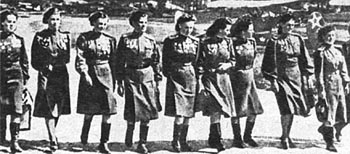 Nachthexen - Pilots from the Russian 588th Night Bomber Regiment L-R : Rufa Gasheva, Natalya Mieklina, Marina Chechenieva, Nadiezhda Popova, Sima Amosova, Dina Nikulina, Yevdikya Bireshanska (Yevodokiya Bershanskaya), Maria Smirnova, Yevgenya Zhygulenko (Yevgeniya Zhigulenko)
The Night Witches were the women of the 588th Night Bomber Regiment. All of the mechanics and bomb loaders of this regiment, as in the 586th IAP and the 587th Bomber Regiment, were also women. The Soviet women bomber pilots earned in total 23 Hero of the Soviet Union medals and dozens of Orders of the Red Banner. Two women bomber pilotsóKatya Ryabova and Nadya Popovaóin one night raided the Germans 18 times. The Po-2 pilots flew more than 24,000 sorties and dropped 23,000 tons of bombs. Most of the women bomber pilots who survived the war in 1945 had racked up nearly 1,000 missions each. They had served so exemplarily throughout the whole war that they participated in the final onslauqht on Berlin. ...more
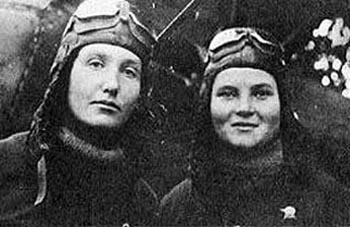 Pilot Tanya Makarova and Navigator Vera Belik Myles, Bruce, Night Witches - The Untold Story of Soviet Women in Combat
The Nachthexen In spite of the rich history of American women in military aviation personified by the Women's Air Service Pilots (WASP's)) in World War II, the U.S. Armed Forces didn't begin training women for air combat service until 1993. Yet, in 1942 the Soviet Union formed three regiments of women combat pilots who flew night combat missions and were so successful and deadly the Germans feared them, calling them "Nachthexen" - night witches.
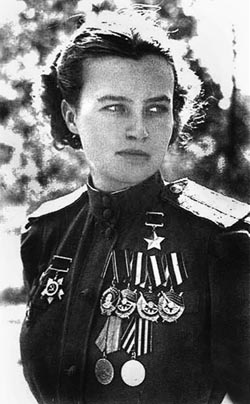 Natalya Meklin, Order of 'Hero of the Soviet Union' Myles, Bruce, Night Witches - The Untold Story of Soviet Women in Combat
The WASP's, unable to convince the military bureaucracy that they were willing and capable of air combat, had to be content to watch their daughters and granddaughters effect the change in U.S. policy 50 years after their service; it was a matter of equality and opportunity. The Soviets used pilots of both genders in World War II out of dire necessity. (The Germans used women test pilots--namely Melitta Schiller and Hanna Reitsch--but they retained civilian status and flew aircraft from the factories to the front; they did not fly in actual combat.) ...more
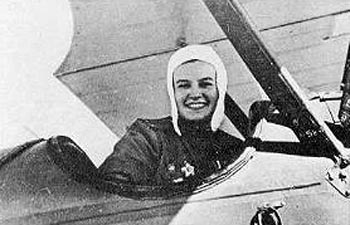 Natalya Meklin in her PO-2 Myles, Bruce, Night Witches - The Untold Story of Soviet Women in Combat
Night Witches : The Movie Malcolm McDowell is to take the lead role in second world war epic Night Witches, which is due to go into production later this year. [Now unsure re time line, most probably 2003 - Ed.] Based on the true story of a squadron of female fighter pilots, the film will mark the directing debut of McDowell's nephew, Alexander Siddig. His only previous experience behind the camera came while directing episodes of Star Trek: Deep Space Nine. McDowell, last seen in the well received British film, Gangster No.1, has just finished work on Dorian, an adaptation of Oscar Wilde's novel The Picture of Dorian Gray, due for release later in the year. Guardian Unlimited 7/2/01 Night Witches : Background In 1942 the Soviet Union formed three regiments of women combat pilots who flew night combat missions of harassment bombing. They flew obsolete Polikarpov Po-2 biplanes, that were otherwise used as trainers, and which could only carry 2 bombs that weighted less than a ton altogether. They were so successful and deadly the Germans feared them, calling them "Nachthexen" - night witches. The Night Witches were the women of the 588th Night Bomber Regiment. All of the mechanics and bomb loaders of this regiment, as in the 586th IAP and the 587th Bomber Regiment, were also women. ...more
Soviet Women Pilots in the Great Patriotic War which says in part... Thousands of Russian women and girls courageously fought for their Rodina (Motherland), serving with the Voyenno-Vozdushniye Sily (Air Forces, in Russian). Women-pilots of female air regiments engaged in dogfights, cleared the way for the advancing infantry and supported them in ground support missions.
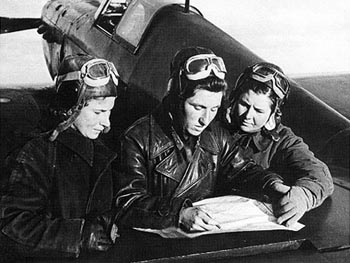 Soviet Fighter Aces from the Russian 586th Women's Fighter Regiment L-R : Lilya Litvyak, 12 kills (KIA), Katya Budanova, 11 kills (KIA) and Mariya Kuznetsova
The fighter pilots of the all-women 586th IAP (Russian abbreviation for Fighter Aviation Regiment, same as Fighter Air Regiment) flew a total of 4,419 sorties (per pilot) and participated in more than 125 separate air battles, in which they massed a total of 38 confirmed kills. The USSR highly praised the combat deeds of female pilots: thousands won orders and medals. 29 won titles of Hero of the Soviet Union. 23 of these went to the Night Witches. read the article in full
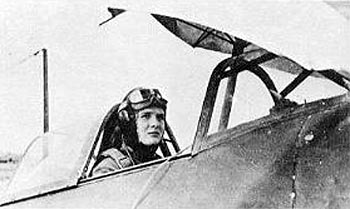
Tanya Makarova, Voronezh Front, 1943 Myles, Bruce, Night Witches - The Untold Story of Soviet Women in Combat
Soviet Women Combat Pilots - The Battle for Moscow In the months leading up to Operation Barbarossa (Hitler's code name for the attack on the Soviet Union) there had been over 500 violations of Soviet airspace by German photo reconnaissance aircraft. On the 21st June 1941 Hitler attacked - his plan to crush the Soviet Union in 10 weeks. Initially the attack exceeded the wildest dreams of the German generals. The Fall of Smolensk to the Germans on July 16, 1941 placed Moscow in danger. Hitler then discontinued the drive to Moscow, ordering the Germans to stand in place - it seemed to postpone the final blow but consequently Moscow received a reprieve during those crucial weeks. When the belated and ill-timed German assault on Moscow (code - named Operation Typhoon) began at 05:30 hours on September 30, 1941 the Russian weather turned foul. ...more
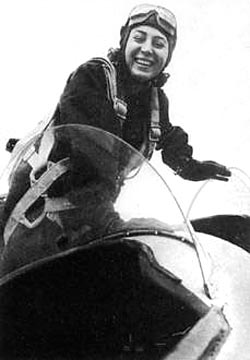 Ekaterina Budanova
Famous Flyers : How they must love their homeland By Phillis Anne Duncan To lead up to the celebration of the 100th Anniversary of the Wright Brothers' famous flight, FAA Aviation News will be reviving a column we put aside some years ago - the historical article that featured either a Famous Flight or a Famous Flyer. This is the first in the rejuvenated series. Much of this article is based on an interview conducted through an interpreter and consists of a one-on-one session with the Editor and also the Editor's listening to the filming of a documentary to be produced about the Soviet airwomen in World War II. Spoken Russian does have a certain lyricism to it - they consider themselves a nation of poets, after all - but when translated loses some of its charm. The resulting English sentence structure is sometimes short and choppy, even a bit stilted, compared to customary English. Russian does not use articles (the, an, etc.), and there is no use of Mister or Miss or Mrs. or Ms in formal or informal speech. Russian men and women are generally addressed by their last names by another Russian; hence, no disrespect is intended by referring to the women in this article in a similar manner. Editor's note.
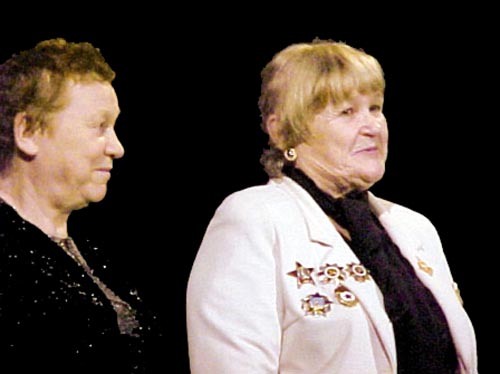 Dr Galina Pavlovna Brok-Beltsova (r) and Galina Korchuganova Korchuganova a former Soviet test pilot and 1966 World Aerobatic Champion joined Dr Brok-Beltsova at the induction of all Soviet Airwomen of WWII into the Aviation Hall of Fame
Photo : Phillis Anne Duncan
"They were attacking my city. There was panic in the streets. What else could I do except join the army? It was my duty."A young man or woman speaking about the events of September 11, 2001? Surprisingly, no. This was a 76-year old woman speaking about her wartime experience. Her war was World War II, or in her vernacular, The Great Patriotic War; the city was Moscow; and she was a 16-year old sports enthusiast who watched the city her family had lived in for three generations be bombed by the Nazis. The year was 1942, and Galina Pavlovna Brok (Beltsova after her marriage) left behind volleyball, swimming, skating, and skiing for a uniform, a sidearm, and the navigator's station in a Soviet Petylakov Pe-2 bomber. (The Pe-2 was a mid-sized twin-engine aircraft converted to a bomber and capable of carrying only one 1,200-pound bomb. At the time, however, it was the most sophisticated aircraft in the Soviet fleet.) Beltsova is one of the then Soviet Union's famed airwomen who flew combat missions along its western front in World War II.
Lieutenant Galina Brok-Beltsova was a navigator with the 125th Regiment. She relates how most of the women pilots were aged about twenty. If they survived to twenty-three, they were considered 'veterans' and were then termed the 'old ladies'. After the war, Galina completed a Doctorate in History and became Head of the History Department at the Moscow Engineering Institute before retiring http://www.aic.gov.auIn 1996 I wrote a profile of the so-called "night witches" in the March issue of FAA Aviation News. I have since learned that some consider "night witches" a derogatory term, especially several scholars who have extensively studied these women and their exploits. This was a term the Germans called them, and Beltsova explained it this way:
"We slept in anything we could find - holes in the ground, tents, caves - but the Germans had to have their barracks, you know. They are very precise. So their barracks were built, all in a neat row, and we would come at night, after they were asleep, and bomb them. Of course, they would have to run out into the night in their underwear, and they were probably saying, - Oh, those night witches!' Or maybe they called us something worse. We, of course, would have preferred to have been called 'night beauties,' but, whichever, we did our job."[...] Accompanying Dr Beltsova was Galina Korchuganova, a former Soviet test pilot and the 1966 World Aerobatic Champion. Korchuganova is the founder and president of 'Aviatrissa', a Russian women's pilot association. A graduate of the Moscow Aviation Institute, Korchuganova sees her new mission, since she retired from test piloting, as preserving not only the history of Russian aviation but Russian women's role in it.
[...] "We have these wonderful examples of the women from the Great Patriotic War," Korchuganova explains, "but no opportunity to put them on display for young women to see that they can do the things we did. No one tells them that. Before, under the Communists, we were told it was our patriotic duty to be nothing but mothers and wives. That hasn't changed."Korchuganova and Beltsova both hope that the honor of being inducted into the Women in Aviation Pioneer Hall of Fame will garner all Soviet and Russian airwomen some publicity. Beyond that, Korchugavnova doesn't see how to attract young women in Russia to aviation. The economy there, though steadily growing, allows very little spare money for hobbies, and overcoming sexist barriers to women pursuing aviation in the military or the state airlines seems overwhelming.
"Russia's young people today can only focus on survival," Korchuganova explains. "The veterans of the Great Patriotic War are ancient history." Even her more recent test piloting exploits are rarely known beyond a circle of aviation historians. Like the World War II veterans in America, hundreds of Soviet veterans die every day, the former airwomen among them.Make sure you take the time read the full article - wonderful stuff [-Ed.]
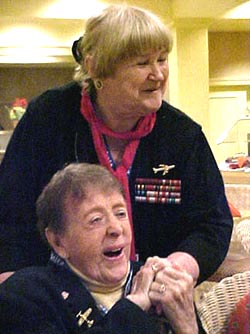 Dr Galina Pavlovna Brok-Beltsova with Bobbi Trout 13th Annual Women in Aviation Conference, Nashville, TN., March 13-14, 2002
Photo courtesy of Nanette Malher of Aviatrix Enterprises
Integration, Leadership & Commitment Some years ago I attended a Women in Management Dinner where a friend of mine received an achievement award in the field of management. The dinner speaker at those awards, was then Commander, now Captain Caroline Brand of the Royal Australian Navy. On the evening of that dinner, Caroline enthralled us with the exploits of Russian Women Bomber Pilots during the second world war and it is my intention, for a little while, to share some of that history with you. The stories of these young women are inspirational, as much for their commitment to die for what they believed in as for their uncompromising attitude to the worth of their womanhood. The stories of these young women are documented in the book A Dance With Death by Anne Noggle. Anne writes, "Soviet Airwomen are credited with being the first of their sex to serve in combat. When Russia was fighting for survival, a famous avaiatrix, Marina Raskova, proposed to the government that female air regiments be formed with volunteer women pilots and other women volunteers to act as mechanics, staff personnel, gunners and navigators. Her proposal was approved and three womens units were formed, one of these being the 46th Guards Bomber Regiment which became the most highly decorated of the three womens regiments and produced twenty three Heroes of the Soviet Union, that country's Highest Honour. This Regiment was awarded High Honours for skill and bravery, being deployed to assault bridges, enemy strongholds, fuel and ammunition dumps, and enemy troop concentrations. The planes they flew carried a crew of two and approximately 1000 kilograms of bombs. Made predominantly of wood and fabric, the aircraft were fire hazards and many accounts given by crews of the night bomber squadrons related to their fear of catching fire and burning to death. Parachutes were expensive and not available until 1944. Between May 1942 and May 1945, the 46th Guards Bomber Regiment flew an estimated twenty four thousand combat sorties, through every kind of weather and conditions. The women - pilots and ground crews alike - lived on the verge of physical collapse. Senior Lieutenant Nina Raspopova of the 46th Guards Regiment relates a combat experience;
"The anti-aircraft guns fired at us fiercely from all directions, and suddenly I felt our aircraft hit. My foot slipped down into an empty space below me; the bottom of the cockpit had been shot away. I felt something hot streaming down my left arm and leg - I was wounded. Blinded by the searchlights, I could discern nothing in the cockpit. I could feel moisture spraying inside the cockpit; the fuel tank had been hit. I was completely disoriented; the sky and earth were indistinguishable to my vision. But far in the distance I could see the sparkle of our regimental runway floodlight, and it helped my orientation. An air wave lifted us and I managed to glide back over the river to the neutral zone, where I landed the aircraft in darkness."Deputy Commander Irina Rakabolskaya tells how the first slogan of the regiment was, "You are a woman and you should be proud of that." She goes on to relate how her good friend Yevgeniya Rudneva, who was awarded the Gold Star (Hero of the Soviet Union) posthumously, was an astronomer and a poet and was also fond of fairy tales.
"When we were not on missions, she would gather us all together at the airfield and recite fairy tales by Zhukovsky. When she was burning, in the air over Kerch, I was standing at the aerodrome watching it. I was losing my friend, she was burning away over my head, and I could do nothing to save her."In addition to the physical strain of combat, these women were coping with little food or sleep and lack of warmth. Most of them were arrested and sent to the guardhouse at some time for exchanging items with the local peasants for food, or chopping up any unused items to make fires for warmth. Lieutenant Polina Gelman was a navigator with the 46th Guards Bomber Regiment. She relates,
"I could go on talking about it because we had been fighting for one thousand nights - one thousand nights in combat. Every day the girls became more courageous. To fly a combat mission is not a trip under the moon..... Every attack, every bombing is a dance with death. In spite of this, every girl knew the danger and none ever refused to fly her mission or used a pretext to avoid participating in a bombing. Our feelings were that we were doing a simple job, just a job to save our country, to liberate it from the enemy."At the height of the bombing of Berlin the allied air casualties became so great that allied bombers stopped their bombing raids. All except one squadron of Russian Bombers who continued despite the danger. They all perished. They were all women. Lieutenant Galina Brok-Beltsova was a navigator with the 125th Regiment. She relates how most of the women pilots were aged about twenty. If they survived to twenty-three, they were considered 'veterans' and were then termed the 'old ladies'. After the war, Galina completed a Doctorate in History and became Head of the History Department at the Moscow Engineering Institute before retiring. She maintains that nothing can be valued as highly as person to person relationships and understanding.
Further Reading On Line
Female Faces of the Air WarWomen in Combat - Nationalism or Patriotism http://lonestar.texas.net
Lilya Litvak - The "White Rose" of Stalingrad.
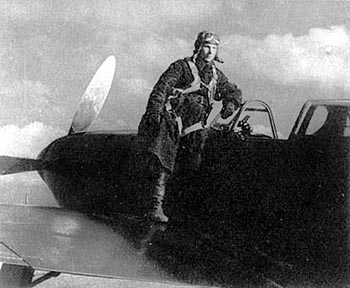 Lilya Litvak c.1943
Nadezhda "Nadya" Popova http://www.itsrussian.com
Women pilots in operational combat - An emotive issue. "The utilisation of women in operational combat flying is an emotive issue. This new age approach of exposing women to the dangers of combat action has two opinion groups - one that demands complete compliance between male and female standards, and the other, the total avoidance of women in combat missions..." So says Col Des Barker, Officer Commanding TFDC, in his comprehensive article titled: Women pilots in operational combat. Besides the aspect of male chauvinism, there is genuine concern by their male colleagues for their safety during combat operations. Whether right or wrong, most cultures regard women as a soft issue and women have therefore, historically been accorded the jobs of home-making while the male has inherited the responsibility of providing protection for the family. Since the so-called liberation of women in the early nineteen hundreds, there has been a gradual demand by women for equality and recognition of their abilities. This has meant that women have entered man's realm of being the warrior. Certain women world-wide are claiming that it is not only their right, but also their duty to conduct combat missions on an equal basis with their male counterparts. Are they equal to the challenge, can they do the job as well as the men? A number of significant issues are addressed, are the issues at stake merely male chauvinism, or gender feminist propaganda? You decide for yourself. ...more
In Print
Here is a superb collection of war-memoirs of Soviet combat-aviators from the original three female regiments organized by Marina Raskova. These were the Yak-1 equipped 586th Fighters, the Pe(Petlyakov)-2 equipped 587th Dive-bombers, and the famous 588th "night witches" who flew Po-2 biplane night-bombers.
These are memoirs of pilots, navigators, gunners, mechanics, armorers, political officers, and regimental and squadron commanders, all in their own words. Most of these memoirs were written very shortly after the War. A few were written during the War, including the diary of navigator Zhenya Rudneva, which ends abruptly as she perished during her 645th bombing mission. In addition there are some moving tributes to fallen comrades. Of particular interest are S. Gribanov's biography of Lidiya "Lilya" Litvyak and I. Pasportnikova's sketch of Katya Budanova. Both of these fighter-pilots had transferred to the elite (predominantly male) 73rd Stalingrad Guards Regiment commanded by N. Baranov, who was coincidentally the original commander of A. Mares'yev. Litvyak and Budanova became "Free Hunters" with the 73rd and achieved ACE status during the air battles over Stalingrad. Both were killed in action in late summer of 1943, and subsequently posthumously decorated with the highest military honor, Hero of the Soviet Union. I find it ironic that there has recently been such an uproar over whether American women can or should participate in tactical aviation, when more than a half-century ago Soviet women did. And not out of Communist ideals or "political-correctness", but simply because their country needed them. Moreover, they acquited themselves well. The 586th held the distinction of never losing to Luftwaffe fire a bomber in the formations they escorted or a ground installation which they defended. The 588th was the first regiment of all the Night Bomber divisions to achieve Guards status, and by the end of the War each of its surviving veterans had made some 800 to 1,000 sorties. But searchlights, anti-aircraft fire, and enemy planes were not the only hurdles they had to overcome. They also faced gender-prejudice. Major V. Markov was at first indignant to be appointed Commander of the 587th Dive-bombers. This decorated officer "couldn't visualize how I could command women during war, flying [the Pe-2] bomber. I knew the aircraft, how difficult it was even for men to fly!" Markov's memoir, exerpted in this collection, relates his change of opinion as his female regiment distinguished itself and was awarded Guards status. Up until his death in 1994, Gen. (ret.) Markov remained a strong advocate of airwomen's capability in combat. [Amazon.com review by Chapulina R., Krasnoe, Russia]
excerpts... "My superiors made no distinction between male and female regiments of which the girls were very proud. I must admit, however, I sometimes wished they remembered that our regiment consisted of women, and would not send them into the very hell. Every pilot, every crew member became dear to me. I loved them all, was proud of them, and dreaded the possibility that any one of them might not return...," wrote Major Valentin Markov, the male commander of the women's dive bomber wing, in this unique collection of WWII memoirs that tell, in a simple, unaffected style, the story of the three women's wings which owed their existence to Marina Raskova, a remarkable pioneer woman navigator-pilot. Of the three women's wings, the night bomber regiment was awarded an unprecedented number of Gold Stars of Hero of the Soviet Union, the highest Soviet decoration, and its aircrews at times flew as many as eighteen short-range missions per night. The unit was staffed exclusively by women. In contrast, the dive bomber and fighter wings included some male personnel, mainly in ground support roles. As well, the fighter wing eventually acquired one male squadron, in part as replacement of a female squadron previously sent to Stalingrad. Alexander Gridnev, the unit's second permanent wing commander, recently presented his controversial memoirs to Reina Pennington, Russian history professor and retired U.S. Air Force captain, for translation into English. The excerpt cited below describes a successful landing in a crippled Pe-2 bomber carried out by Aleksandra (Sasha) Krivonogova, flight commander of the 125th Dive Bomber Regiment: "They were fully aware of the gravity of their situation. Their aircraft was uncontrollable. With throttle control alone it was possible to fly straight only, albeit with difficulty, but one could not fly straight indefinitely. "...Instead of proceeding home in a joint formation, Krivonogova had to fly along the front line for some time in the dense explosions of anti-aircraft shells. Ably manoeuvring her engines' power settings, she slowly-on the verge of stalling-turned her crippled machine and headed toward home airfield. The forty minutes of flying seemed like an eternity. Finally, the airfield appeared below them. Here, aircraft that had just landed were quickly taxiing away, clearing the runway. An ambulance and a tractor sped to the scene. On the ground, all knew that Krivonogova was attempting to land. Her landing approach had to be absolutely faultless, with no misses or errors of any kind, since the control wheel of the machine was dead. The pilot had but the engines and trim tabs at her disposal. "The nerves of the observers on the ground were strained to the utmost. Krivonogova's ground support personnel were incapable of looking at the field. Then the bomber smoothly touched down and sped along the runway. Finally, the pilot switched off the engine, the propellers stopped, and a collective sigh of relief rolled over the airfield. Flight, ground support, and command personnel-all ran to the aircraft to congratulate the pilot. "She certainly deserved to be congratulated! She had manifested an unusual skill, self-possession, and presence of mind. Then a messenger ran out from the HQ, carrying a telegram from the command element of the ground troops which the bomber group had supported-thanking us for a job exceptionally well done. Soon the aircraft of the corps commander himself touched down on the airfield; the general came to congratulate Krivonogova in person and to announce that she would be awarded the Order of Patriotic War I Class for her valour and skill. We counted fifty-seven shot-holes in her aircraft!"
The biographies of Soviet female military recipients of the Hero of the Soviet Union award, and spanning the period from Pre-world War II to 1990. The selection includes all branches of the military, from partisans and medical personnel to tank commanders and political officers
"Most of the women whose stories were selected for inclusion in this book are recipients of the coveted Hero of the Soviet Union (HSU) award. This prestigious list includes women from all combat services, but the majority are either Red Air Force pilots or participants in the Soviet resistance. Almost all Soviet women pilots seemed to have been inspired by a trio of female aviation pioneers named Valentina Grizodubova, Polina Osipenko and Marina Raskova. These three women became as famous in the Soviet Union during the 1930's as Amelia Erhardt was in the West" [emphasis -Ed.]. "Grizodubova went on to command a regiment consisting of all men, the only instance of this ever happening, while Raskova formed the first women's regiments and commanded one of them until her death in January of 1943 (Osipenko died in a plane crash before the war). In what seems very unusual to an American reader, bomber/ground attack pilots received much more recognition than fighter pilots. In fact, the only Soviet woman fighter pilot to be named as a Hero of the Soviet Union was Lidya Litvyak, who was awarded the honor posthumously in 1990, nearly 50 years after having been killed in action in August of 1943." "Whenever I was reading through the bios of the women of the Red Army and Air Force, I was glad to learn that many of these heroines lived long and healthy lives after the war and that a good number of them were still alive as of the late 1990s." [Amazon.com review by Jon Eckel, Los Angeles, CA USA]
By the close of World War II almost 1,000 Russian women had flown combat missions in every type of Soviet warplane. This was kept secret, not by the Soviets but by the allies, from the general public in the West. Using historical fiction based on fact Roy McShane's exciting novel reveals for the first time what truly deadly hunters these women fighter pilots proved to be.
The author herself a former WW II WASP pilot , now a retired Capt., USAF, went to the Soviet Union to interview many former Soviet Women combat Air crew. They formed the 46th and 125th Guards Bomber Regiments & the 586th Fighter Regiment, plus numerous others flew in all-male Regiments.
These brave women, the first ever to fly in combat, proved that women could be among the best of warriors, withstanding the rigors of combat and downing the enemy. The women who tell their stories here began the war mostly as inexperienced girlsmany of them teenagers. In support of their homeland, they volunteered to serve as bomber and fighter pilots, navigator-bombardiers, gunners, and support crews. Flying against the Luftwaffe, they saw many of their friends-as well as many of their foes-fall to earth in flames. Their three combat Air Force regiments fought as many as one thousand missions during the war. For their heroism and success against the enemy, two of the women's regiments were honored by designation as "Guard" regiments. At least thirty women were decorated with the gold star of Hero of the Soviet Union, their nation's highest award. But equally courageous were the women's efforts to show the Red Army that they were entirely adequate to the great role they sought. For even though Stalin had decreed equality for both sexes, the women had to grapple initially with deep distrust from male pilots and Red Army officers, against whom they eventually prevailed. War, Stalin-era politics, and human emotion mix in these gripping, first-person accounts. Supported by photographs of the women at war, the stories are unforgettable. Portraits of the women as they are now, taken by award-winning photographer Anne Noggle, add the perspective of time to the experiences of the survivors of this great dance with death. [Summary by : Articles of War Ltd, Silver City, NM, U.S.A]
The Soviet Union was the first nation to allow women pilots to fly combat missions. During World War II the Red Air Force formed three all-female units--grouped into separate fighter, dive bomber, and night bomber regiments--while also recruiting other women to fly with mostly male units.
These regiments flew a combined total of more than 30,000 combat sorties, produced at least thirty Heroes of the Soviet Union, and included at least two fighter aces. Among their ranks were women like Marina Raskova, the "Soviet Amelia Earhart," a renowned aviator who persuaded Stalin in 1941 to establish the all-women regiments; the daredevil "night witches" who flew ramshackle biplanes on nocturnal bombing missions over German frontlines; and fighter aces like Liliia Litviak, whose twelve "kills" are largely unknown in the West. Here, too, is the story of Aleksandr Gridnev, a fighter pilot twice arrested by the Soviet secret police before he was chosen to command the women's fighter regiment. Pennington draws upon personal interviews and the Soviet archives to detail the recruitment, training, and combat lives of these women. Deftly mixing anecdote with analysis, her work should find a wide readership among scholars and buffs interested in the history of aviation, World War II, or the Russian military, as well as anyone concerned with the contentious debates surrounding military and combat service for women. [Summary by : Articles of War Ltd, Silver City, NM, U.S.A]
The Soviet Union was the first nation to allow women pilots to fly combat missions. During World War II the Red Air Force formed three all-female units--grouped into separate fighter, dive bomber, and night bomber regiments--while also recruiting other women to fly with mostly male units. Their amazing story, fully recounted for the first time by Reina Pennington, honors a group of fearless and determined women whose exploits have not yet received the recognition they deserve. Pennington chronicles the creation, organization, and leadership of these regiments, as well as the experiences of the pilots, navigators, bomb loaders, mechanics, and others who made up their ranks, all within the context of the Soviet air war on the Eastern Front. These regiments flew a combined total of more than 30,000 combat sorties, produced at least thirty Heroes of the Soviet Union, and included at least two fighter aces. Among their ranks were women like Marina Raskova, the "Soviet Amelia Earhart," a renowned aviator who persuaded Stalin in 1941 to establish the all-women regiments; the daredevil "night witches" who flew ramshackle biplanes on nocturnal bombing missions over German frontlines; and fighter aces like Liliia Litviak, whose twelve "kills" are largely unknown in the West. Here, too, is the story of Aleksandr Gridnev, a fighter pilot twice arrested by the Soviet secret police before he was chosen to command the women's fighter regiment. Pennington draws upon personal interviews and the Soviet archives to detail the recruitment, training, and combat lives of these women. Deftly mixing anecdote with analysis, her work should find a wide readership among scholars and buffs interested in the history of aviation, World War II, or the Russian military, as well as anyone concerned with the contentious debates surrounding military and combat service for women.
"Pennington conveys wholly fresh, vivid, often unique and revealing insights drawn from a formidable and fascinating array of evidence. Much of her book is deeply moving. It is impossible not to be stirred, even appalled, by the fate of some of these women." --John Erickson, author of The Road to StalingradReina Pennington, a former intelligence officer with the Air Force and Defense Intelligence Agency, is director of Peace, War and Diplomacy Studies at Norwich University in Vermont. She is editor of Military Women Worldwide: A Biographical Dictionary and author of numerous articles in Air & Space/Smithsonian, Air Force Magazine, Airpower Journal, and Journal of Slavic Military Studies.
|
© Copyright 1999-2002 CTIE - All Rights Reserved - Caution |
